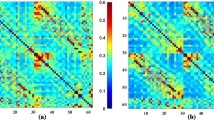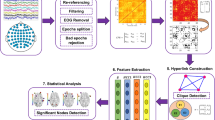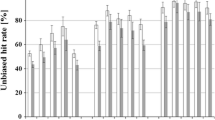Abstract
ADHD defects the recognition of facial emotions. This study assesses the neurophysiological differences between children with ADHD and matched healthy controls during a face emotional recognition task. The study also explores how brain connectivity is affected by ADHD. Electroencephalogram (EEG) signals were recorded from 64 scalp electrodes. Event-related phase coherence (ERPCOH) method was applied to pre-processed signals, and functional connectivity between any pair of electrodes was computed in different frequency bands. A logistic regression (LR) classifier with elastic net regularization (ENR) was trained to classify ADHD and HC participants using the functional connectivity of frequency bands as a potential biomarker. Subsequently, the brain network is constructed using graph-theoretic techniques, and graph indices such as clustering coefficient (C) and shortest path length (L) were calculated. Significant intra-hemispheric and the inter-hemispheric discrepancy between ADHD and healthy control (HC) groups in the beta band was observed. The graph features indicate that the clustering coefficient is significantly higher in the ADHD group than that in the HC group. At the same time, the shortest path length is significantly lower in the beta band. ADHD’s brain networks have a problem in transferring information among various neural regions, which can cause a deficiency in the processing of facial emotions. The beta band seems better to reflect the differences between ADHD and HC. The observed functional connectivity and graph differences could also be helpful in ADHD investigations.




Similar content being viewed by others
References
Abdi H (2007) Bonferroni and Šidák corrections for multiple comparisons. Encyclopedia of measurement and statistics 3:103–107
Ahmadlou M, Adeli H (2010) Wavelet-synchronization methodology: a new approach for EEG-based diagnosis of ADHD. Clin EEG Neurosci 41(1):1–10
Ahmadlou M, Adeli H (2011) Functional community analysis of brain: A new approach for EEG-based investigation of the brain pathology. Neuroimage 58(2):401–408
Ahmadlou M, Adeli H, Adeli A (2012) Graph theoretical analysis of organization of functional brain networks in ADHD. Clin EEG Neurosci 43(1):5–13
Alba G, Pereda E, Mañas S, Méndez LD, Duque MR, González A, González JJ (2016) The variability of EEG functional connectivity of young ADHD subjects in different resting states. Clin Neurophysiol 127(2):1321–1330
Allen JJ, Coan JA, Nazarian M (2004) Issues and assumptions on the road from raw signals to metrics of frontal EEG asymmetry in emotion. Biol Psychol 67(1–2):183–218
Arns M, Conners CK, Kraemer HC (2013) A decade of EEG theta/beta ratio research in ADHD: a meta-analysis. Journal of attention disorders 17(5):374–383
Association GA (2014) World Medical Association Declaration of Helsinki: ethical principles for medical research involving human subjects. The Journal of the American College of Dentists 81(3):14
Barkley RA, Fischer M, Smallish L, Fletcher K (2006) Young adult outcome of hyperactive children: adaptive functioning in major life activities. J Am Acad Child Adolesc Psychiatry 45(2):192–202
Barttfeld P, Petroni A, Báez S, Urquina H, Sigman M, Cetkovich M, Torralva T, Torrente F, Lischinsky A, Castellanos X (2014) Functional connectivity and temporal variability of brain connections in adults with attention deficit/hyperactivity disorder and bipolar disorder. Neuropsychobiology 69(2):65–75
Bridges, R. M. (2018). "ADHD Diagnosis In University Settings: The Utility Of Quantitative EEG Coherence."
Bullmore E, Sporns O (2009) Complex brain networks: graph theoretical analysis of structural and functional systems. Nat Rev Neurosci 10(3):186–198
Bussalb A, Collin S, Barthélemy Q, Ojeda D, Bioulac S, Blasco-Fontecilla H, Brandeis D, Ouakil DP, Ros T, Mayaud L (2019) Is there a cluster of high theta-beta ratio patients in attention deficit hyperactivity disorder? Clin Neurophysiol 130(8):1387–1396
Çelik, Z. Ç., Ç. Çolak, M. A. Di Biase, A. Zalesky, N. Zorlu, E. Bora, Ö. Kitiş and Z. Yüncü (2019). "Structural connectivity in adolescent synthetic cannabinoid users with and without ADHD." Brain imaging and behavior: 1–10.
Coan JA, Allen JJ (2004) Frontal EEG asymmetry as a moderator and mediator of emotion. Biol Psychol 67(1–2):7–50
Collin L, Bindra J, Raju M, Gillberg C, Minnis H (2013) Facial emotion recognition in child psychiatry: a systematic review. Res Dev Disabil 34(5):1505–1520
Conners CK, Sitarenios G, Parker JD, Epstein JN (1998) The revised Conners' Parent Rating Scale (CPRS-R): factor structure, reliability, and criterion validity. J Abnorm Child Psychol 26(4):257–268
Cortese S (2012) The neurobiology and genetics of attention-deficit/hyperactivity disorder (ADHD): what every clinician should know. European journal of paediatric neurology 16(5):422–433
Da Fonseca D, Seguier V, Santos A, Poinso F, Deruelle C (2009) Emotion understanding in children with ADHD. Child Psychiatry Hum Dev 40(1):111
de Haan W, Pijnenburg YA, Strijers RL, van der Made Y, van der Flier WM, Scheltens P, Stam CJ (2009) Functional neural network analysis in frontotemporal dementia and Alzheimer's disease using EEG and graph theory. BMC neuroscience 10(1):101
de Vico Fallani F, Richiardi J, Chavez M, Achard S (2014) Graph analysis of functional brain networks: practical issues in translational neuroscience. Philosophical Transactions of the Royal Society B: Biological Sciences 369(1653):20130521
Delorme A, Makeig S (2004) EEGLAB: an open source toolbox for analysis of single-trial EEG dynamics including independent component analysis. J Neurosci Methods 134(1):9–21
Dickinson A, DiStefano C, Lin Y-Y, Scheffler AW, Senturk D, Jeste SS (2018) Interhemispheric alpha-band hypoconnectivity in children with autism spectrum disorder. Behav Brain Res 348:227–234
FDA-NIH Biomarker Working Group. BEST (Biomarkers, E., and other Tools) Resource [Internet]. Silver Spring (MD): Food and Drug Administration (US); 2016-. Diagnostic Biomarker. 2016 Dec 22. Available from: https://www.ncbi.nlm.nih.gov/books/NBK402285/ Co-published by National Institutes of Health (US), Bethesda (MD).
Fitzgibbon SP, DeLosAngeles D, Lewis TW, Powers DM, Whitham EM, Willoughby JO, Pope KJ (2015) Surface Laplacian of scalp electrical signals and independent component analysis resolve EMG contamination of electroencephalogram. Int J Psychophysiol 97(3):277–284
Franciotti R, Falasca NW, Arnaldi D, Famà F, Babiloni C, Onofrj M, Nobili FM, Bonanni L (2019) Cortical Network Topology in Prodromal and Mild Dementia Due to Alzheimer’s Disease: Graph Theory Applied to Resting State EEG. Brain Topogr 32(1):127–141
Gadow, K. D. and J. Sprafkin (1997). Child Symptom Inventory 4: CSI, Checkmate Plus.
García-Prieto J, Bajo R, Pereda E (2017) Efficient computation of functional brain networks: towards real-time functional connectivity. Frontiers in neuroinformatics 11:8
Ghaderi AH, Nazari MA, Shahrokhi H, Darooneh AH (2017) Functional brain connectivity differences between different ADHD presentations: impaired functional segregation in ADHD-combined presentation but not in ADHD-inattentive presentation. Basic Clini Neurosci 8(4):267
González JJ, Méndez LD, Mañas S, Duque MR, Pereda E, De Vera L (2013) Performance analysis of univariate and multivariate EEG measurements in the diagnosis of ADHD. Clin Neurophysiol 124(6):1139–1150
Haufe S, Meinecke F, Görgen K, Dähne S, Haynes J-D, Blankertz B, Bießmann F (2014) On the interpretation of weight vectors of linear models in multivariate neuroimaging. Neuroimage 87:96–110
Herrera-Díaz A, Mendoza-Quiñones R, Melie-Garcia L, Martínez-Montes E, Sanabria-Diaz G, Romero-Quintana Y, Salazar-Guerra I, Carballoso-Acosta M, Caballero-Moreno A (2016) Functional connectivity and quantitative EEG in women with alcohol use disorders: a resting-state study. Brain Topogr 29(3):368–381
Hosein Din, F. G. (2018). "Can Brain Networks Reveal the Emotional Faces` Information?" First International Sharif Neuroscience Symposium.
Kayser J, Tenke CE (2015) On the benefits of using surface Laplacian (current source density) methodology in electrophysiology. Int J Psychophysiol 97(3):171
Kerson C, deBeus R, Lightstone H, Arnold LE, Barterian J, Pan X, Monastra VJ (2020) EEG Theta/Beta Ratio Calculations Differ Between Various EEG Neurofeedback and Assessment Software Packages: Clinical Interpretation. Clin EEG Neurosci 51(2):114–120
Liu T, Chen Y, Lin P, Wang J (2015) Small-world brain functional networks in children with attention-deficit/hyperactivity disorder revealed by EEG synchrony. Clin EEG Neurosci 46(3):183–191
Liu T, Lin P, Chen Y, Wang J (2014) Electroencephalogram synchronization analysis for attention deficit hyperactivity disorder children. Bio-Med Mater Eng 24(1):1035–1039
Lucey, P., J. F. Cohn, T. Kanade, J. Saragih, Z. Ambadar and I. Matthews (2010). The extended cohn-kanade dataset (ck+): A complete dataset for action unit and emotion-specified expression. 2010 IEEE Computer Society Conference on Computer Vision and Pattern Recognition-Workshops, IEEE.
Mackenzie GB, Wonders E (2016) Rethinking intelligence quotient exclusion criteria practices in the study of attention deficit hyperactivity disorder. Frontiers in Psychology 7:794
Michelini, G., J. Jurgiel, I. Bakolis, C. H. Cheung, P. Asherson, S. K. Loo, J. Kuntsi and I. Mohammad-Rezazadeh (2018). "Atypical functional connectivity in adolescents and adults with persistent and remitted ADHD." BioRxiv: 201772.
Ortega R, López V, Carrasco X, Anllo-Vento L, Aboitiz F (2013) Exogenous orienting of visual-spatial attention in ADHD children. Brain Res 1493:68–79
Park JH, Hong JS, Han DH, Min KJ, Lee YS, Kee BS, Kim SM (2017) Comparison of QEEG findings between adolescents with attention deficit hyperactivity disorder (ADHD) without comorbidity and ADHD comorbid with Internet gaming disorder. J Korean Med Sci 32(3):514–521
Polanczyk GV, Willcutt EG, Salum GA, Kieling C, Rohde LA (2014) ADHD prevalence estimates across three decades: an updated systematic review and meta-regression analysis. Int J Epidemiol 43(2):434–442
Pourabbasi.P (2015). "Analysis of Brain Event Related Potentials in Children with ADHD During Facial Expression Recognition." biomedical engineering faculty, amirkabir universtiy of technology.
Razavi.M, S. (2017). "Investigation the function of the brain in the recognition of facial emotions in children with attention deficit hyperactivity disorder (ADHD) compared with healthy children using the event related potentials (ERP) method". Faculty of advanced medical technology,Tehran university of medical science.
Rohrer-Baumgartner N, Zeiner P, Egeland J, Gustavson K, Skogan AH, Reichborn-Kjennerud T, Aase H (2014) Does IQ influence Associations between ADHD Symptoms and other Cognitive Functions in young Preschoolers? Behav Brain Funct 10(1):16
Rubinov M, Sporns O (2010) Complex network measures of brain connectivity: uses and interpretations. Neuroimage 52(3):1059–1069
Sakkalis V (2011) Review of advanced techniques for the estimation of brain connectivity measured with EEG/MEG. Comput Biol Med 41(12):1110–1117
Schmid R, Tirsch W, Scherb H (2002) Correlation between spectral EEG parameters and intelligence test variables in school-age children. Clin Neurophysiol 113(10):1647–1656
Snyder SM, Hall JR (2006) A meta-analysis of quantitative EEG power associated with attention-deficit hyperactivity disorder. J Clin Neurophysiol 23(5):441–456
Solomon E, Kragel J, Sperling MR, Sharan A, Worrell G, Kucewicz M, Inman CS, Lega B, Davis KA, Stein JM (2017) Widespread theta synchrony and high-frequency desynchronization underlies enhanced cognition. Nature communications 8(1):1704
Thatcher R, Palmero-Soler E, North D, Biver C (2016) Intelligence and eeg measures of information flow: efficiency and homeostatic neuroplasticity. Scientific reports 6(1):1–10
Van Wijk, B. C., C. J. Stam and A. Daffertshofer (2010). Comparing brain networks of different size and connectivity density using graph theory. PloS one 5(10).
Wainer, J. and G. Cawley (2018). Nested cross-validation when selecting classifiers is overzealous for most practical applications. arXiv preprint arXiv:1809.09446.
Watts DJ, Strogatz SH (1998) Collective dynamics of ‘small-world’networks. Nature 393(6684):440
Yao Z, Zhang Y, Lin L, Zhou Y, Xu C, Jiang T, Initiative ASDN (2010) "Abnormal cortical networks in mild cognitive impairment and Alzheimer's disease. PLoS Comput Biol 6(11):e1001006
Yu C-L, Chueh T-Y, Hsieh S-S, Tsai Y-J, Hung C-L, Huang C-J, Wu C-T, Hung T-M (2019) Motor competence moderates relationship between moderate to vigorous physical activity and resting EEG in children with ADHD. Mental Health and Physical Activity 17:100302
Zhang J, Wang J, Wu Q, Kuang W, Huang X, He Y, Gong Q (2011) Disrupted brain connectivity networks in drug-naive, first-episode major depressive disorder. Biol Psychiat 70(4):334–342
Zou H, Hastie T (2005) Regularization and variable selection via the elastic net. J Royal Statistical Soc 67(2):301–320
Author information
Authors and Affiliations
Corresponding author
Additional information
Communicated by Micah M. Murray.
Publisher's Note
Springer Nature remains neutral with regard to jurisdictional claims in published maps and institutional affiliations.
Appendices
Appendix 1
In this Appendix, details of corrected p-values as well as size effect for significant main effect “Disease” in Table1 and interaction effect “Disease × Emotions” (in four emotions) in Tables 2, 3, 4 and 5 for the features of connectivity are provided. These details are related to Fig. 3b and c.
Appendix 2
In this Appendix, details of corrected p-values as well as size effect for significant main effect “Disease” in Table1 and interaction effect “Disease × Emotions” (in four emotions) in Tables 2, 3, 4 and 5 for the features of shortest path lenght (L) are provided. These details are related to Fig. 4a.
Appendix 3
In this Appendix, details of corrected p-values as well as size effect for significant main effect “Disease” in Table1 and interaction effect “Disease × Emotions” (in four emotions) in Tables 2, 3, 4 and 5 for the features of clustering coefficient (C) are provided. These details are related to Fig. 4b.
Appendix 4
In this part, the rationale behind sample size (enrolling 49 participants) is provided. The sample size is calculated by the following formula:
where α is the type I error, p refers to proportion estimation, and d is the acceptable error in estimating the desired ratio.
In this study, we considered α = 0.05 so \({Z}_{1-\frac{\alpha }{2}}=1.96\). Due to the literature review (Polanczyk, Willcutt et al. 2014), the ADHD’s proportion (prevalence of ADHD) is estimated as 5%, so p = 0.05. Finally, the accepted error is considered as d = 0.1 in this study. Therefore, the sample size calculated as follows:
So we had to have 19 participants (with the 10% acceptable error) in each group. If we wanted to be more precise, we had to put the acceptable error as 5%. Then, the sample size would be:
Based on the limitations (time and budget), the acceptable error is considered to be 10%. SO, in the ADHD group, we had 24, and in the HC group, we had 25 participants.”
Rights and permissions
About this article
Cite this article
Dini, H., Farnaz.Ghassemi & Sendi, M.S.E. Investigation of Brain Functional Networks in Children Suffering from Attention Deficit Hyperactivity Disorder. Brain Topogr 33, 733–750 (2020). https://doi.org/10.1007/s10548-020-00794-1
Received:
Accepted:
Published:
Issue Date:
DOI: https://doi.org/10.1007/s10548-020-00794-1




